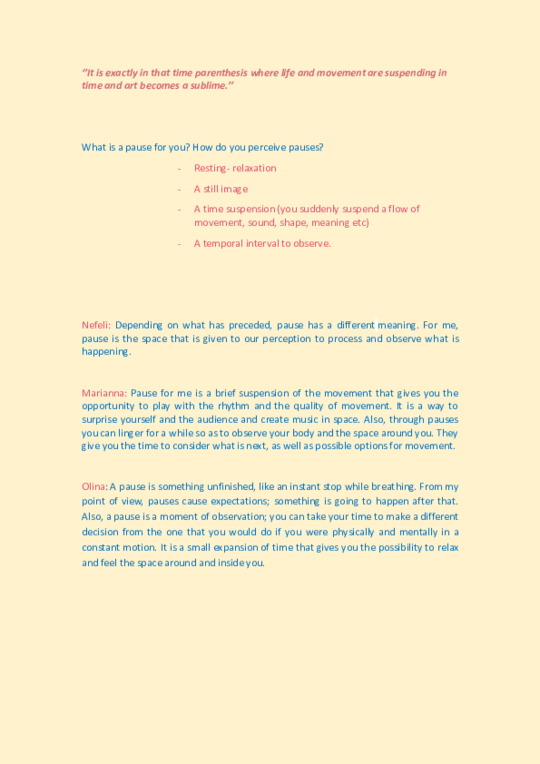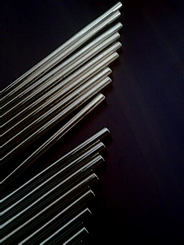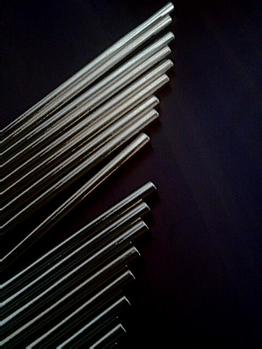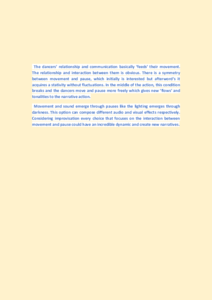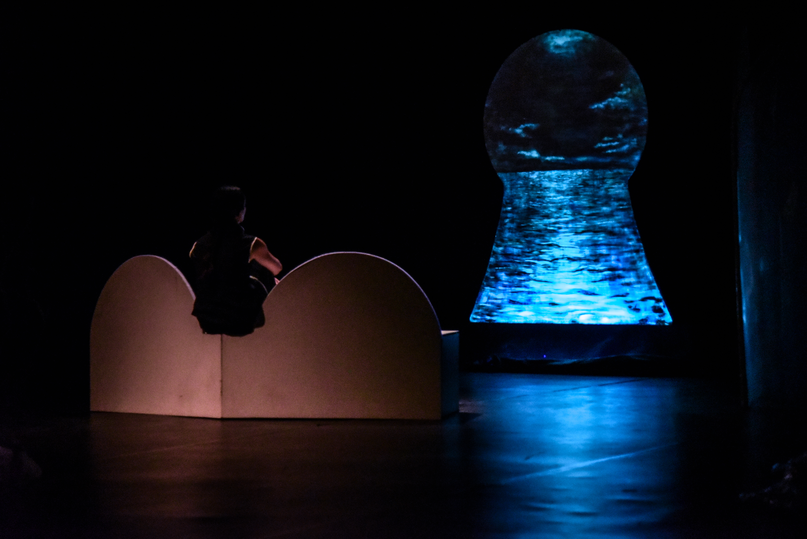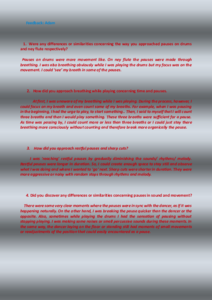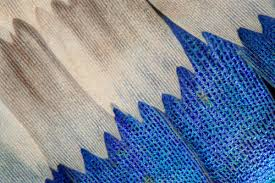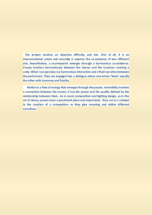Description/ Illustration
Regarding the score, there were three tasks/ stations:
1. 1. You pause while you are moving. You interrupt something in the mid-action.You suddenly suspend a flow of movement.
2. 2. ‘Go’ to restful positions while you are moving and rest in them.
3. 3. 'Go' to inconvenient, unbalanced standing postures and stay still.
Following my initial research concerning the temporality of the pauses, I asked from the dancers to ‘play’ also with the duration of the pauses in each of the tasks.
The dancers didn't follow specific 'points' in time and space (time and space lines) while performing the score. They were free to move from one task to another whenever they had a specific intention or sensorial reaction. It was the improvisation itself, the relationship between them, the urgency that arose from the pauses that made them shift from one task to another. The ultimate goal was to see whether these diverse kinds of pausing and also their duration could shift their perception and also the perception of the audience concerning possible narrations that might emerge while improvising
In this light, the dancers explored four different improvisational scores:
1. The dancers followed simultaneously the same order concerning the tasks of the score. They shifted together from one task to the other. So, they moved from restful positions to tensed standing still postures and finally they paused while they were moving (movement interruption). -video one-
2. The dancers followed simultaneously the same order concerning the tasks of the score. They shifted together from one task to the other. So, they moved from movement interruption to tensed standing still postures and finally to restful positions. -video two-
3. The dancers followed simultaneously the same order concerning the tasks of the score. They shifted together from one task to the other. However, I felt that another change in the order would have more or less the same outcomes. So, I asked from the dancers to move only from restful positions to movement interruption. I felt that restful positions and movement interruption were respectively the two edges of a line concerning relaxation and tension. -video three-
4. The fourth version was an open score. The dancers didn't follow the same order concerning the tasks of the score. The dancers didn’t shift simultaneously from one task to the other. They could freely change the tasks making their own interpretation of the order. -video four-
(Regarding the first three scores, I’ve chosen to present you a short summary, because I want to show a longer edition of the open score, which I believe worked better- see reflection below.)
TAKE YOUR TIME TO LOOK
Reflecting…
‘’The body is not just an object, it is our pre-condition to be able to experience’’
‘’The (material) body is our main vehicle to know the world’’
As Ponty claims, we are able to understand the world and the concepts of reality we create through our sensory-motor system.
Intensifying our sensory and motor functions we could expand our perception and thus develop our awareness.
Scores are a useful tool not only for structuring an improvisational performance, but also for research and investigation. Furthermore, they are a supportive method for practicing perceptual awareness especially in the fields of instant composition and improvisation. They could be encountered or experienced as dynamic networks of perception, witnessing, action and response where presence is invoked or shaped. Presence, in turn, leads the process of ‘catching’ simple or subtle realities or possible narratives in conceptual space-time (Bellerose, 2015, p. 5). Improvisers turn in this way the everyday space-time to a space-time of magic, drawing essences from the environment and within the body, (re)constructing narratives. In this sense, improvisers could even process the come and go in-between the worlds of consciousness and unconsciousness (Bellrose, 2015, p. 19). You need, however, to invest time in practice, so as to accomplish that.
Regarding the scores I explored in the studio with the three dancers, they were really inspirational and explanatory concerning my research question. They also 'revealed' possible aspects of my subject topic in terms of my final project.
Considering the first two videos, a crescendo and a diminuendo in regards to tensity was respectively being created. Going from restful positions to standing still and then to movement interruption, I had a sensation of ‘rising’; the dancers were gradually ‘moving’ from relaxation to tension. Reversing the score, qoing from movement interruption to tensed and then to restful positions, a sensation of ‘diminishing was being created as the dancers were gradually ‘moving’ from tension to relaxation.
The above scores worked a lot to me, because I am interested in experimented on restful and tensed atmospheres concerning my final project. (you watched only a summary of the scores, because I didn’t have enough time to present the whole process).
So, I will explore more profoundly in the future the qualities of ‘rising’ (from restfulness to tension) and ‘diminishing’ (from tension to relaxation) through the aforementioned scores.
Considering the third score where the dancers moved from restful positions to movement interruption, my sensation is that it wasn’t successful enough. Due to lack of time, you watched only a short edition of it. Nevertheless, I felt that the transition from the first to the second task wasn’t organic, due to the nature of the tasks. They are opposites. They stand at the edges of a line concerning relaxation and tension. So, the dancers got confused. However, I believe that through constant practice it is possible to shift organically from the first task to the second and reversed.
I’m also interested in investing more time in this score in the future: As light doesn’t exist without darkness and sound without silence, stillness doesn’t not exist without motion. They are parts of a whole. The one gives meaning to the other; motion is essential to make stillness stand out. So, sharp sudden stops in movement will make restfulness stand out.
The open score was clearly more illustrative concerning my research question whether diverse kinds of pausing would influence the ‘realities’ the improvisers create. The dancers were now more focus on the relationship they were developing, rather than on trying to follow the same task simultaneously and shift together from one task to the other.
I noticed that different types of pausing create various qualities of reality and narrations: restful or playful atmospheres, dynamic or rhythmic dialogues, abstract or ‘realistic’ narratives and images ... and this is full of elusiveness and fluidity. Our perception is constantly changing. The same kind of pausing and at the same 'extend' may create different readings and meanings the very next moment.
What is really important is to be present and aware so as to perceive the ‘imaginary worlds' that are being created and thus ‘shape’ new narratives or develop the existing ones. I find it important to engage the dancers into more open scores in the future. This will be really helpful so as for them to widen their perception and awareness and be, therefore more alert regarding the meaningful environments they form through ‘stillness’ while improvising.
Scores as a method of investigation:
Following the aforementioned research, I've focused on exploring more profoundly the described above diverse kinds of pausing. Playing also with the duration of the pauses, I engaged the dancers into open improvisational scores. I've also tried out the open score with a musician playing the drums and the ney flute.
Many artists and artistic researchers in dance, music and theater use scores in a variety of ways. Postmodern choreographers like Deborah Hay, Trisha Brown, Lisa Nelson, Nancy Stark Smith, Ruth Zaporah, as well as contemporary choreographers like Jonathan Burrows and William Forsythe among others give structure to their performances using specific scores. Other approaches are meant to cultivate group connection or create a common ground prior to the performance moment.
American Philosopher Alva Noë(2015), when referring to Tuning Scores, an approach to spontaneous ensemble composition, devised by post-modern choreographer and practitioner researcher Lisa Nelson, underlines her understanding of Tuning Scores as a research tool for the study of perceptual consciousness (p. 124). Noë (2015) states that ''… A tuning score is an activity of bringing the world into focus for perceptual awareness. It is an activity of attuning onself to what is happening around one (p. 127). ...Every dancer is a behaver and a perceiver. They experience the environment... not the physical world, but the meaningful worlds they create while improvising... we as spectators see this enviroment, gaining clarity in this way about the worlds we inhabit (p. 126).
In this sense, my intention was to explore through open scores whether and at what extent these diverse kinds of pausing could assign the relationship created between the dancers and also between the dancer and the musician with diverse meanings. I wanted to see with what kind of qualities or concepts of reality diverse kinds of pausing would inform their improvisation.
1st intervention
Working with the three dancers, one day before entering the studio, I've e-mailed them, attachinhg a file:
Conclusion
The musical composer John Gage said in his interview about silence: ‘’There is no such think as silence. The silence almost everywhere in the world now is traffic.’’
Contemporary humans, living on technological worlds and digital realities, are usually too busy physically and mentally. They are constantly travelling through increasable actions and thoughts. They do not pause; they do not stay ‘still’; They feel awkward when being ‘silent’ trying to fill in the gap. They are not, therefore, present in their lives.
In this sense, it is important to ‘apply’ the quality of ‘Maah’ in our everyday life. The essence of pausing lays on a relaxed mind that provides us with a ‘quiet place’ to think, feel, experience and perceive. It is a state of a meaningful silence; a state that promotes presentness and awareness.
Furthermore, living in busy minds, it is essential that all this ‘silence’ is shared. Artists have the power to affect an audience. When they communicate a sense of presence, the audience feels Maah. In this light, It is important to create an abstract narration of restfulness, giving the possibility to the audience to experience the silence.Within this reality, every concept, quality or narration is possible; diverse qualities of reality can endlessly be born. This is an ongoing process, full of fluidity and always open for discussion!
Considering the lockdown that was imposed to most places of the world due to Coronavirus pandemic, I felt that this period was a long durational pause; as if the world was in a speedy vehicle that gradually slowed down and finally came to a pause. Despite the fact that it was an imposed one, I had the time to understand the essentiality of pauses.
Pauses are essential temporal intervals that provide us with time to rest, to gain strength, to re-think, to re-adjust, to become conscious of something, to understand changes, to see from the whole perspective.
Looking for interconnections between pauses in movement improvisation and the aforementioned quality of time wideness, pauses could also be encountered as a stretching of time- a time expansion- an opportunity to expand our perception and thus broaden our awareness, following or not what’s there at the moment while improvising.
Except for the fact that pauses allow the dancers to rest, considering instant composition and improvisation, they provide the dancers with time to observe, to ‘look’ back and front, to connect with the space, to choose something else, to re-direct their choices, to feel that something has ended, to see new options.
Furthermore, they allow the audience to rest and also enable the spectators to observe and pay attention to something, understand and create narrations or diverse qualities of reality through the pauses, as well as give a 'meaning' to the proceeded dance.
In this light, my research emphasizes in the way diverse kinds of pausing can create diverse narrations or qualities of reality both in the dancers' and audience's perception, providing them with the possibility to observe and thus shift or re-derict their perception.
Abstract
French phenomenological philosopher Maurice- Merleau Ponty (1908-1961) wrote on perception and embodiment. In his view, we are embodied beings positioned in this world Our body is the primary site of understanding the world. We are able to experience and perceive the world through our sensori-motor systems. According to Ponty's philosophy, the essence of existence, as well as the essence of art lies on perception. Perception creates reality. The body is our main vehicle to create a world, while our bodily experience of movement provides us with a way of access to it. Our bodily presence in space enables us to create as many realities in the world as living beings on the planet (Merleau-Ponty, 1962).
In this sense, regarding instant composition and dance improvisation, American philosopher Alva Noë (2015) writes that ‘’When we as dancers enter the ’image space’, … when we listen, and watch, we make the environment. … We enact our perceptual world by attuning ourselves to it’’ (p. 126). Improvisers discover and create diverse concepts and qualities of reality based on their perceptual understanding of the ‘imaginary worlds’ that they encounter when entering the space. They cultivate and expand their perception and understanding of what is happening around them while improvising through practicing and studying daily their perceptual awareness.
On that basis, time and temporality as fundamental resources of instant composition, are also explored by experienced improvisers. ''Time is, as Steve Paxton calls it, ‘a fiction’ (how can something that feels so different to us in different situations be ‘real’?)’’ (De Spain, p. 114). It is within Merleau-Ponty’s phenomenological approach of existence that we can interpret our different perception and experience of time, since we constitute time from our perspective (Freeman, 2004, p. 648). In this light, practitioners discover and create similarly diverse concepts and qualities of temporality. They expand their perception concerning temporality by intensifying their sensorial perceptions through their practice.
Considering time and temporality, 'be at the moment' is fundamental characteristic in instant composition and improvisation. But which moment is present? Time is passing and therefore ’be at the moment’ is not about distinguishing and ‘running after’ the present moment. In this sense, we would focus on ‘counting’ and ‘chasing’ the moments, instead of being ‘at the moment’. Thus, 'be at the moment' is creating a wider present, within which we feel time widening as a sensation. Within this time expansion we are able to gradually develop our sensory-motor systems while improvising. This, in turn, enables us to expand our perception and develop our consciousness. We may, therefore, have the possibility to perceive anything that may be present in our 'inner world' on the one hand and the surroundings on the other. This wide-now experience makes us able to observe or pay attention to our thoughts and our body, to the qualities of movement and the developing relationships, to space and temporality. In this way, we become able to understand and 'attune' ourselves to abstract or realistic narrations, concepts or qualities of reality we create while improvising. We could even dive deeper into our presence, revealing ‘hidden’ unconscious thoughts, memories and intuitions that might become in this way conscious.
Mobilizing research in action
American postmodern innovative choreographers of Judson Dance Theater (Deborah Hay, Yvonne Rainer, Lisa Nelson, Steve Paxton, Nancy Stark Smith, Anna Halprin etc), as well as contemporary re-known choreographers like Meg Stuart and William Forsythe among others, focus on experiencing through the sensory-motor systems while dancing. They are interested in the ways the dancers may feel and understand the 'perceptual realities' they create when entering the 'dance space', as well as in the ways they could sense together. In this sense, they emphasize in improvisational tasks and 'experience' exercises that offer the dancers the possibility to intensify their senses and therefore expand their perception and awareness.
Being influenced by their artistic research and also inspired by movement artist Daniell Lepkoff's interview by Myriam Van Imschoot, published in Contact Quarterly in 2001 (pp 26-29), I prepared three diverse improvisational tasks concerning diverse kinds of pausing that I worked alone and also with professional dancers in the studio. Daniel Lepkoff, having worked with the choreographers Mary Fulkerson and Steve Paxton, has experienced and researched respectively on restful positions and standing still.
Wondering on the ways I physically perceive pauses, I came to three versions that I technically explored in the studio with the dancers. I focused on experiencing bodily stillness in standing tensed positions and relaxation in restfull positions on the floor. I also experimented on pausing while moving. I worked separately on each task, giving enough time to each of them, so as for the dancers to have a profound bodily experience of pausing.
Furthermore, in my attempt to understand the essence of pauses, I emphasized in the temporality of pauses while moving. I tried to understand whether the duration and rhythm of the pauses could ‘change’ the way of moving. Apart from their impact on movement, I explored whether the temporality of the pauses could shift the perception of the dancers and the audience, giving diverse meanings not only to stillness but also to the proceeded dance.
Diving deeper into my research, I added an extra layer to the improvisational task, asking from the dancers to develop a relationship through the temporality of their pauses. I wanted to see whether this could assign their dialogue with a ‘meaning’.
Me and the dancers could see that shorter pauses 'shaped' a dynamic, rhythmic with musicality 'converasation'. In addition to that, they created a playful atmosphere concerning the quality of the relationship the dancers were 'building'. On the other hand, long durational pauses created a restful, 'nostalgic' atmosphere as if past experiences and memories were brought into surface. Moreover, they gave me and also the dancers the possibility to understand possible narrations that were being created concerning their relationship while the dancers were improvising.
TAKE A GLIMPSE
Comparing:
Below you can find an inventory of similarities or differences I have ‘traced’ concerning qualities of reality, diverse kinds of pausing, the temporality of the pauses, as well as the relationship built between the performers, create in the performers’ and the audience’s perception respectively.
Diverse kinds of pausing:
Resting positions:
The dancers: They were concentrated on their body, trying to let the gravity act upon the whole body; as the body was relaxing, it released its shape and took the shape that gravity gave it. They felt that their weight was gradually falling into the ground, leaving its ‘echo’ behind.
They had a sense of relaxation and restfulness, as if it was Sunday morning.
Furthermore, they had the time and space to observe their thoughts. They were free to choose the thoughts they would focus on. They could even dive into deeper thoughts or past experiences and memories.
The musician: He was 'reaching' restful pauses by gradually diminishing the sounds/ rhythms/ melody; as if the sound was leaving its 'echo' behind… Restful pauses were longer in duration. He could create in this way enough space so as to stay still and observe what he was doing and where he wanted to 'go' next.
The audience: The sound and movement were gradually diminishing.
Sometimes, resting positions gave the sensation of nostalgia, as if all this restfulness and relaxation brought into surface past experiences and images.
Standing still:
The dancers: They felt that they were more concentrated on their body, trying to ‘hold’ the muscles they needed and simultaneously let go the ones they didn't need in order to keep standing. They felt that they were approaching an edge; they were at a risk.
They sensed that they were engaged with a 'small dance', despite the fact that they stood still: they made small moves, readjustments of the position or vibrations in order to keep standing still.
The musician: Sometimes, while playing the drums he had the sensation of pausing without stopping playing. He was making some noises or small percussive sounds during these moments.
The audience: They could see the dancers’ effort to stand still. The dancers were present concerning their struggle to stay in the position. The audience could experience the temporal aspect of their action. They could sense the duration of their effort. Experiencing the present time while observing the dancers, a sensation of relaxation and inner calmness was proceeding the dancers’ struggle to stand still; when the dancers were achieving to stay still without engaging into small moves or readjustments of the position, a restful quality of reality was being created.
Pausing while moving- movement interruption
The dancers: They felt that these pauses were a ‘breath’, a time ‘suspension’ in movement, providing them with time to redirect their choices.
The musician: He felt this sound interruption as sharp cuts that were short in duration. They were more aggressive or noisy with random stops through rhythms and melody.
The audience: Movement interruption created phenomenologically the perception to the audience that movement continued sensing what the next action would be.
In addition to that, it gave the impression of a video pause (as if the video stopped playing), creating, in turn, a ‘suspension’ in the meaning concerning the ‘realities’ and ‘worlds’ the performers were developing.
What is more, the audience felt these pauses as restful moments for the gaze, especially when the dancers and the musician were constantly moving/ playing.
Duration of the pauses:
Long durational pauses:
The dancers: Longer pauses gave them the time to observe, to ‘look’ back and front, to connect with the space, to consider or reconsider their relation to others, to choose something else, to re-direct their choices, to feel that something has ended, to see new options. Also, they had the opportunity to observe the relationship that was being developed with the other dancers. They could see the qualities of reality, the meanings and narrations they were creating through pauses while improving.
Furthermore, long pauses provided them with a ‘space of freedom’. They could dive into the infinite ‘world’ of thoughts and consideration. They could see beyond the phenomena; they could 'put' into the microscope small or detailed moves; intangible thoughts and memories: they could float into the invisible ‘realm’ of unconsciousness.
The musician: Longer pauses, especially restful ones, provided him with time to observe or pay attention to something.
The audience: Long durational pauses were shifting their perception concerning what the next action would be. They had the time to thoroughly observe, create a narrative through the image of a pause or give a ‘meaning’ to the proceeded dance.
Short durational pauses:
The dancers: Shorter pauses gave them the opportunity to play with the rhythm or create music in space. Also, they could develop diverse movement qualities like percussive or ballistic movement.
The musician: In his view, shorter pauses were sharp cuts that were more aggressive or noisy with random stops through rhythms and melody.
The audience: Short pauses created a dynamic or rhythmic dance. Sometimes, it was full of playfulness or musicality.
Relationships:
The dancers: When one of the dancers was pausing and the others were moving, she felt like an observer that was trying to understand the other dancers’ feelings and intentions or ‘ideas’, as well as the ‘worlds’ they were creating. When the dancers were pausing simultaneously, they felt that they were travelling together into the ‘unknown’; everything could appear from this darkness, this nothingness...
The musician: He was trying to communicate with the dancer through the pauses; without sounds, movements or words. It was meaningful to him. In an attempt to understand their reality, he delved into observation. Being, also, ‘silent’ inside, he could see the pauses as the ‘negative space’ of their reality: through this ‘stillness’ every possible reality might emerge.
The audience: Pauses, as essential parts of a whole, provided the improvisational dialogue between the performers with a meaning or defined various narratives. Diverse kinds of pauses concerning their quality or duration affect differently the flow of motion and thus they create diverse concepts and qualities of reality or narrations.
Other artists and artistic researchers working on ‘stillness’
‘Microscopy of dance’
In the early 1970s, the American innovator Steve Paxton developed a dance he called ‘the stand’. Before or after a dance the dancers are asked to stand still and focus on all kinds of activities that are necessary to prevent the body from collapsing. It is seen as a meditative state. The dancers become aware of all the physical, mental and physiological processes that keep the body standing. So, physical sensation is connected to perception and awareness.
This is quite close to my perception concerning the essence of pauses as a state of perception and awareness. The dancers, while pausing, have the time to focus on all their physical activities. They are able to concentrate on their breath and their 'interior world'. They can observe their attention, as well as their imagination or their desires. They are even able to put into the microscope other dancers’ small and detailed moves.
Steve Paxton (1977) said about ‘the stand’ : ‘’Well, first of all, it's a fairly easy perception: all you have to do is stand up and then relax -you know- and at a certain point you realize that you've relaxed everything that you can relax but you're still standing and in that standing is quite a lot of minute movement...the skeleton holding you upright even though you're mentally relaxing... Call it the 'small dance' ...It was a name chosen largely because it's quite descriptive of the situation and because while you're doing the stand and feeling the 'small dance' you're aware that you're not 'doing' it, so in a way, you're watching yourself perform; watching your body perform its function. And your mind is not figuring anything out and not searching for any answers or being used as an active instrument but is being used as a lens to focus on certain perceptions.’’
‘The stand’ requires a perceptual shift on the dancer’s body. Stillness in ‘the stand’ phenomenologically is not that of the statues, since it engages small, reflexive and vibratory moves that allow the body to stand. The writer, curator and dramaturg André Lepecki (2000), investigating the phenomenology of stillness, gave to this ‘small perception’ the term microscopy of perception.
Concerning my research, similarly, both the dancers and the musician observed this small reflexive dance, the vibrations and readjustments of the position that the dancers were doing while being in tensed standing postures. In their attempt to stand still, they were engaged into this kind of ‘small dance’. In addition to that, dancers noticed that they had to concentrate more on their body trying to hold and simultaneously release every muscle they didn’t need in order to keep standing still. So, their attention and therefore their perception shifted toward their body within this state of pausing.
Regarding contemporary choreographer Meg Stuart’s work, the body is at the central focus of her concerns and that’s because she feels that there is a neglect in contemporary society of attention in the body. She looks at the body as a physical narrative, always loaded with diverse social and cultural meanings. Personal and bodily exposure to public space is important to her. She works with stillness, as a form of microscopy that creates the right conditions for personal exposure (Jeroen Fabious, 2004).
Stuart is well-known for working with near still bodies and minimal movements. She says (2002): ‘‘It’s not frozen, it’s liminal. Liminal is when something is becoming but not quite becoming’’(Husemann, 2002, p. 34). It is in this respect that Lepecki speaks about the microscopic, how Stuart and other choreographers are making the spectator look at minute movement in the body, vibrations rather than movement (Lepecki, 2000).
Her interest in ‘stillness’ can also be seen in the way she sees time. She thinks that time can be stretched or shortened. She uses ‘over-time’ (extended time) by slowing down the actions of the dancers. She gives in this way the time to the audience to see beyond the first, to see more than one image or relationship and make associations. She is interested in non-linear narratives, but in associative readings. Thus, the moments ‘in between’, where nothing happens, the spectators have the time not only to feel and experience the duration of time, but also see diverse possible qualities or concepts of reality (Fabious, 2004).
What is more, by exposing to the public gaze the dancer’s body in uncomfortable positions using a time expansion, she expresses a wish to break down the barrier between public and performer, and the expectations of showing off in front of an audience (Fabious, 2004).
Concerning my research, I explored diverse kinds of pausing, approaching bodily stillness through a phenomenological perspective: in restful positions there was a gradual surrendering to gravity; in tensed standing postures there was this ‘small dance’ taking place in order to stand still; in movement interruption, the dancers’ breath and attention kept on moving despite the fact that their body was ‘frozen’. In this respect, Stuart encounters ‘stillness’ from a phenomenological approach, using minimal, imperceptible movements and slow motion.
However, while stuart uses ‘stillness’ and pause in order to expose the body and create in this way sociopolitical narratives, I mainly explored the notion of pauses through bodily experience.
The essence of long durational pauses as moments of ‘silent focus’ and perceptual expansion could also be seen in the moments of nothingness in Meg Stuart’s work. Since, she does not aim to control or project a particular meaning, she creates space for the audience to observe, allowing their perception to shift and broaden creating multiple meanings and narratives.
‘Still acts’
The writer, curator and dramaturg André Lepecki (2001) uses the expression ‘still acts’ when referring to French choreographer Jérôme Bel ’s overall work. According to Lepecki, stillness emerged in moments of historical anxiety as the body’s response to these moments. In the early 1990s, several choreographers gathered in Paris for a month-long intensive residency (1st edition of SKITE, organized by French critic and programmer Jean-Marc Adolphe). They stated that they didn’t feel like dancing due to socio-political circumstances. Vera Mantero, Meg Stuart, Paul Gazzola, Santiago Sempere are some of the choreographers present that produced work around immobility, slowness, arrest. This symbolic and expressive ‘stillness’ is phenomenologically a powerful action of resistance. It’s not freezing. Instead, the subject creates a new relationship with time and temporality, engaging into different experiences of perceiving one’s presence (lepecki, 2001, p. 2).
For the anthropologist and cultural critic Nadia Seremetakis (1996) ‘still acts’ are those moments of pause and arrest in which the subject disrupts the flow of temporality, shaking out ‘historical dust’. In contemporary societies, history stands so still that it produces dust. Modern way of living ‘seals’ our senses, diminishing in this way quietly and collectively our perceptual awareness. By standing still dancers do not betray dance. Instead, they propose another dance in which time expands, allowing discarded, yet necessary thoughts, feelings, notions, gestures and sights to emerge again in the social surface (Seremetakis, 1996).
In this sense, Jérôme Bel in The Last performance (1995), through circular repetition of the same dance piece performed by different dancers, produces a statement against the attachment of dance to the subject in western dance; one of the dance’s basic ideological norms lays on the fact that dance’s being is isomorphic to the dancer’s moving presence; the dancer, since he/she inhabits a body, is entrapped by the body-image. Thus, Bel’s accumulating quotations are encountered as ‘still acts’, as actions of resistance to the aforementioned notion. They bring into surface the autonomy and single entity of dance and the subject respectively. By hiding the dancer with a black square cloth held by two of the dancers, he wants to peel off dance from the dancer and release them from their entrapment by the body-image.
Following that, while I am recently exploring pauses through a bodily experience of diverse kinds of ‘stillness’, Jérôme Bel encounters ‘stillness’ from a phenomenological, historical and political perspective. In addition to that, pauses for me are the ‘negative reality’ of dance that provide us with time in order to observe and thus broaden our perception and awareness. On the other hand, rather than seeing stillness as dance’s negative, Jérôme Bel shows how dance can always reinvent embodiment, subjectivity and the sensorial by reclaiming corporeal attitudes otherwise discarded as in/significant (Lepecki, 2001, p.3). However, considering the latter one, I could find a resemblance in regards to the time expansion ‘still acts’ provide us with in order to ‘see’ thoughts, feelings, gestures and notions hidden under the ‘historical dust’.
‘Maah’- ‘Moonlight peeping through the doorway’.
Diving deeper into my theoretical investigation, I came across the Japanese space-time concept of Maah, which describes the way Japanese see the notion of pause. It transcends the whole Japanese History and culture and it is encountered in all the aspects of Japanese life. It is mostly a process, rather than a fixed idea. It has many signs as space-time ritual practice, while its cultural significance re-appears in Butoh cosmology. Surfing along Japanese history, Maah’s definition has shifted. From being two parts of a whole (the male and the female, the man and the god), it became the interval in-between two or more edges. The meaning of Maah is an in-between definition – it lives in relation to other things. The Japanese pictorial – kanji – for Maah, can be read as ‘between; within a definite space’. The poetic analysis of it is ‘moonlight peeping through the doorway’ (Bellerose, 2015, pp. 11-15).
Maah is the negative space, the void, the emptiness, the stiliness, the silence from which every creation is generated and every meaning is created. It is not superficial and awkward. It is not empty. It is full of emotion and feelings, sensations and intuition. It is up to humans to create the meaning. Thus, ‘Maah’ is the fundamental time and space life needs to grow.
Movement artist and artistic researcher Christine Bellerose (2015) wrote about the interconnection between Maah and Merleau-Ponty’s phenomenology of the lived body. Humans experience space-time through their bodily existence. Space-time becomes a bodily language enlivened through conscious movement. As dance exists through the human body and is expressed through the human movement, it involves lived human time and human space (Fraleigh, 1987). In this sense, Maah has no body, but it is always present. It exists in the in-between space-time. Through movement observation, intention, and image conjuring, ma as ephemeral space-time manifests itself (Bellerose, 2015, pp. 5, 17).
The artist Martine Viale creates site-specific performances in public spaces working on Maah as an interval between her and the space (‘Ma Intervalle’ project). For example, in one of her performances she was half hiding in a public bus-stop shelter. The passengers could see a double of her (Project 29 with La Centrale). She had a multiplicity of presence. She was, and she was in the reflection of the glass panel. It was hard to define what the interval was. Viale perceives the interval as a perspective of every “possibles”. In the silence of the interval, there is the possibility of an act. The void, the empty space is where Maah manifests; It is full of possibilities; it is through which every possible ‘reality’ may arise (Bellerose, 2015, p. 29).
Martine Viale’s spatial approach of pause differs from my approach of pauses from a temporal perspective. Linking pause and stillness to ‘Maah’ and the in-between space is really inspirational. It opens the door for new perspectives concerning tension in relationships created through the negative space. In addition to that, ‘Maah’ activates the void, the space, engaging the audience with a participatory alertness.
However, I can trace a fundamental resemblance between Maah and my perception concerning the essence of pausing. The musician noticed (intervention two) that as we were ‘giving up’ to total silence, letting go thoughts and desires, a negative reality was being created. Pauses were seen as an empty space, a void through which meaningful worlds were emerging. Furthermore, one of the dancers felt that pauses gave her the possibility to dive into deeper thoughts and unconscious memories; to create an in-between space between consciousness and unconsciousness.
Description / Illustration
Pauses are common in all the aspects of everyday life, in nature and in the Universe. The living beings of the planet inhale, exhale and pause while breathing. They go to sleep in order to rest. Some animals go into hibernation during the Winter and some trees throw their leaves in Autumn. The planets burn, so as to restart again.
Considering the global nature of pauses, I was curious to try the score described in the first intervention in interaction with a musician. I wanted to see what kind of ‘realities’ would be created through ‘silence’ when sound and movement engage into a conversation with each other; my wish was to test whether the aforementioned diverse kinds of pausing would ‘inform’ the relationship created while improvising between music and dance with diverse qualities of reality; Could the pauses create a meaningful environment? Could ‘silence’ expand the dancers' and the musician’s, as well as the audience's perception in regard with a variety of narrations?
I chose the medium od music/ sound, because music is ‘time’ for me. Also, my focus concerning pauses is on their temporality and its impact on movement itself, as well as on diverse qualities of reality that it could create.
Furthermore, music is ‘made’ by creating sounds through pinching, hitting or blowing the air that surround us. The way we shape the sounds and the gaps between them, shapes the ‘whole’ creating in this way a variety of ‘realities’ or narrations and meanings. American violinist Isaac Stern described music as “that little bit between each note – silences which give the form’’ (Fletcher, 2001).
So, at first, me and the musician experimented on the open score using drum set (video one). Percussion, especially all kinds of drums are close to the ‘notion’ of pauses, regarding their sound, structure, shape, way of playing. You can stop them easily and create quickly pauses between the sounds. The way of playing percussion is also in this mode. You can produce silent or restful moments easily and fast.
Then, we explored the open score using the ney flute (video two). Breathing is a way of counting time in music, due to its repetitive motif of inhaling, exhaling and pausing. So, we chose this instrument, because its mode of playing is based on breathing.
Regarding the score, we followed the same score with the dancers. There were three tasks/ stations:
1. Pause while you are playing/ moving (You interrupt something in the mid-action; you suddenly suspend a flow of movement).
2. Go to either restful pauses or sharp cuts while you are playing/ moving. (Sharp cuts could be translated into the inconvenient, unbalanced standing postures that the dancers explored regarding their score.)
3. Maintain a transparency of pausing while playing/ moving.
Following my investigation with the dancers I added the ‘layer’ of maintaining the transparency of stillness/ pause while moving/ playing as a task. It is a common sense that nothing is still in life. Our imagination and our attention, our breath and our eyes, our inner and outside world are constantly moving, even if we stay still.
In addition to that, I was inspired by movement artist Daniel Lepkoff’s interview on Contact Quarterly in 2001. He said (2001) ‘’ There may be a lot of tension and holding in the body when you suddenly suspend a flow of movement; the openness and softness is in the motion of the observing self within one's stillness. Perhaps the essence of stillness is having time to perceive. I think it is possible to maintain the transparency of stillness while one is moving.’’ (Lapkoff, 2001, pp. 26-29).
In this sense, adding this task I wanted to explore the ways we could maintain the essence of pauses as a way of studying perception while moving/ playing.
Considering the order we would follow concerning the tasks of the score, I decided to ‘open’ the score from the beginning. Following my research with the dancers, my experience was that going from restful to tensed positions and then to movement interruption, a crescendo concerning tensity was being created. Reversing the score, a diminuendo was respectively being created. Moreover, I noticed that the dancers, following the same order and trying to change the task simultaneously, were more technically committed to the score, not being able to focus on their relationship.
In this light, when working with the musician, we were not doing simultaneously the same tasks in the same order. We were free to move from one task to the other following our impulses, intentions and urgencies that arose from the dialogue itself and the pauses. It was our relationship, our dialogue and the ‘reality’ that was being created that made us change the task.
TAKE YOUR TIME TO LOOK
Reflecting…
As it has been mentioned before, open scores are a very useful tool for investigation. They can enrich and support the artistic research the practitioners are engaged into, unpacking diverse aspects of their practice. Scores can be a great way to train or bring to surface certain material, or a special focus that will deepen the moment. In this sense, scores could affect the behavior of the performers, linking to various types of interaction.
This had been my original goal concerning the application of theory into practice. Linked to Merleau-Ponty’s view that perception creates reality and our interaction with the world, my wish was to understand what kind of perceptual ‘realities’ the interaction between the performers in 'silence' would create.
I was pleased to see that pauses are similar in sound and movement because of the echo or stops they are portraying in each of these forms. They are different too, because when pauses are found in different media, it is normal that they take other forms. However, apart from the way they transform through media, concepts or thoughts, they portray a universal notion of stillness.
In this light:
- Me and the musician had the same urgency to move or play.
- We were developing a rhythmical, playful, dynamic conversation through random short pauses.
- Longer pauses were giving us the time and space to observe and expand our perception considering the ‘realities’ we have ‘shaped’ or the ones that would follow next.
- When ‘reaching’ restful pauses, we could both see a gradual diminishing of movement and sound respectively; as an echo.
- I was inspired by the musician’s notice that he felt that sometimes he was pausing even though he didn’t stop playing. He was making some noises or small percussive sounds. This could be encountered as the ‘small dance’, the small readjustments or vibrations my body was doing in an attempt to stay still while being in inconvenient, unbalanced standing postures.
In my opinion, the open score with the ney flute didn’t work a lot. The outcome was a synchronized dialogue without any nuances in meanings and qualities of reality. Me and the musician were inhaling, exhaling and pausing together. Considering the fact that the ney’s mode of playing is based on breathing, I felt that we were following the same pace of breathing creating a repetitive conversation. However, this could also be considered as a quality of reality, created through synchronization and repetition in pausing.
In addition to that, this ongoing procedure gave me the possibility to expand my imagination and bring to surface the image of the faun in ‘’L’Après midi d'un faune’’, performed and choreographed by Vaslav Nijinski in 1912. As time was passing by, I didn’t improvise at all. I got into a performative mode; I was performing the faun, creating a narrative of a lazy, narcissist faun… This could also be encountered as a quality of reality that was created through the pauses. The narrative that emerged out of imagination had as a starting point the synchronization and repetition in pausing.
Regarding, the theory’s integration into practice, I think that the open score with the drum set was more successful considering a variety of ‘realities’ me and the musician could develop through ‘silence’. The musician was able to create easily restful and sharp pauses due to percussions’ mode of playing. This provided him with flexibility in pausing, which in turn, made him able to concentrate on the ‘environment’ we were creating.
It was an experimental dialogue. We were both in a constant attempt to experience and understand the ‘realities’ we were building through pauses … and this could also be described as a specific quality of reality. As time was passing by, we kept on looking for what kind of reality we were creating; we were trying to communicate through pauses; we were observing each other; especially in long durational pauses … and this had been a meaningful environment which enabled us to understand possible narrations or not.
The musician's feedback about ‘a negative reality’ that we were creating when the 'silence' became almost total, was really inspirational. When we both stopped thinking and seeking, we entered into a state of a silent focus. New concepts and qualities of reality, new meanings and narrations could effortlessly come out of this ‘silence’, this emptiness; we surrendered into our 'negative reality' We could even ‘reach’ organically a pause together. We could maintain the essence of pauses even while moving/ playing.
Merleau-Ponty’s philosophy is primarily based on perception through bodily experience. As it has been mentioned above, improvisational scores are a supportive research tool for perceptual awareness. Furthermore, the essence of pausing lays on the possibility they provide us to widen our perception.
Being ‘silent’ inside, me and the musician were able to perceive the ‘realities’ we were ‘shaping’ while improvising: as time was passing by, we were more committed to experience the diverse kinds of pauses. This enabled us to understand the ‘essence’ of pausing. We could, therefore, expand our perception and broaden our awareness. This, in turn, enabled us to understand the realities we were 'building' and thus create and develop as many ‘realities’ we could.
We shaped our reality through emptiness
giving up to 'stillness'
We surrendered to 'our negative space'
seeing our imaginary worlds emerging…
(Following my experience, open scores need time and practice. I am interested in working more on the score with drum set in the future.)
2nd intervention
Working with the musician, one day before entering the studio, I've e-mailed him, attachinhg a file consisted of an interview and a improvisational score:
ABSTRACT
French phenomenological philosopher Maurice- Merleau Ponty (1908-1961) wrote on perception and embodiment. In his view, the essence of existence, as well as the essence of art lies on perception. To him, we are embodied beings positioned in this world. Our body is the primary site of understanding the world. We are able to experience and perceive the world through our sensori-motor systems. According to Ponty's philosophy, the body is our main vehicle to create a world, while our bodily experience of movement provides us with a way of access to it. Our bodily presence in space enables us to create as many realities in the world as living beings on the planet. Ponty emphasizes that perception creates reality and our understanding of the world. (Merleau-Ponty, 1962).
In this sense, regarding instant composition and dance improvisation, American philosopher Noë(2015) writes that ‘’When we as dancers enter the ’image space’, … when we listen, and watch, we make the environment. … We enact our perceptual world by attuning ourselves to it’’ (p. 126). Improvisers discover and create diverse concepts and qualities of reality based on their perceptual understanding of the ‘imaginary worlds’ that they encounter when entering the space. They cultivate and expand their perception and understanding of what is happening around them while improvising through practicing and studying daily their perceptual awareness.
On that basis, time and temporality as fundamental resources of instant composition, are also explored by experienced improvisers. ''Time is, as Steve Paxton calls it, ‘a fiction’ (how can something that feels so different to us in different situations be ‘real’?)’’ (De Spain, p. 114). It is within Merleau-Ponty’s phenomenological approach of existence that we can interpret our different perception and experience of time, since we constitute time from our perspective (Freeman, 2004, p. 648). In this light, Practitioners discover and create similarly diverse ‘concepts’ and ‘qualities’ of temporality. They expand their perception concerning temporality by intensifying their sensorial perceptions through their practice.
Considering time and temporality, 'be at the moment' is fundamental characteristic in instant composition and improvisation. Time is passing and therefore ’be at the moment’ is not about distinguishing and ‘running after’ the present moment. In this sense, we would focus on ‘counting’ and ‘chasing’ the moments, instead of being ‘at the moment’. Thus, 'be at the moment' is creating a wider present, within which we feel time widening as a sensation. This in turn enables us to gradually develop our sensory-motor systems while improvising, expanding our perception and developing our consciousness. We may, therefore, have the possibility to perceive anything that may be present in our 'inner world' on the one hand and the surroundings on the other. This wide-now experience makes us able to observe or pay attention to our thoughts and our body, to the qualities of movement and the developing relationships, to space and temporality. In this way, we become able to understand and 'attune' ourselveves to abstract or realistic narrations, concepts or qualities of realities we create while improvising. We could even dive deeper in our presence, revealing 'hidden' unconscious thoughts, memories and intuitions that might become in this way conscious.
Looking for interconnections between pauses in movement improvisation and the aforementioned quality of time wideness, pauses could also be encountered as a stretching of time- a time expansion- an opportunity to expand our pereception and thus broaden our awareness, following or not what’s there at the moment while improvising.
Pauses are essential temporal intervals that provide us with time to rest, to gain strength, to re-think, to re-adjust, to become conscious of something, to understand changes, to see from the whole perspective. Pauses in instant composition and improvisation provides dancers with time to observe, to ‘look’ back and front, to connect with the space, to choose something else, to re-direct their choices, to feel that something has ended, to see new options.
Furthermore, they allow the audience to rest and also enables the spectators to observe and pay attention to something, understand and create narratives or diverse qualities of realities through the pauses, as well as give a 'meaning' to the proceeded dance.
In this light, my research emphasizes in the way diverse kinds of pausing can create diverse narratives or qualities of reality both in the dancers' and audience's perception, providing with the possibility to observe and thus shift or re-derict our perception.
